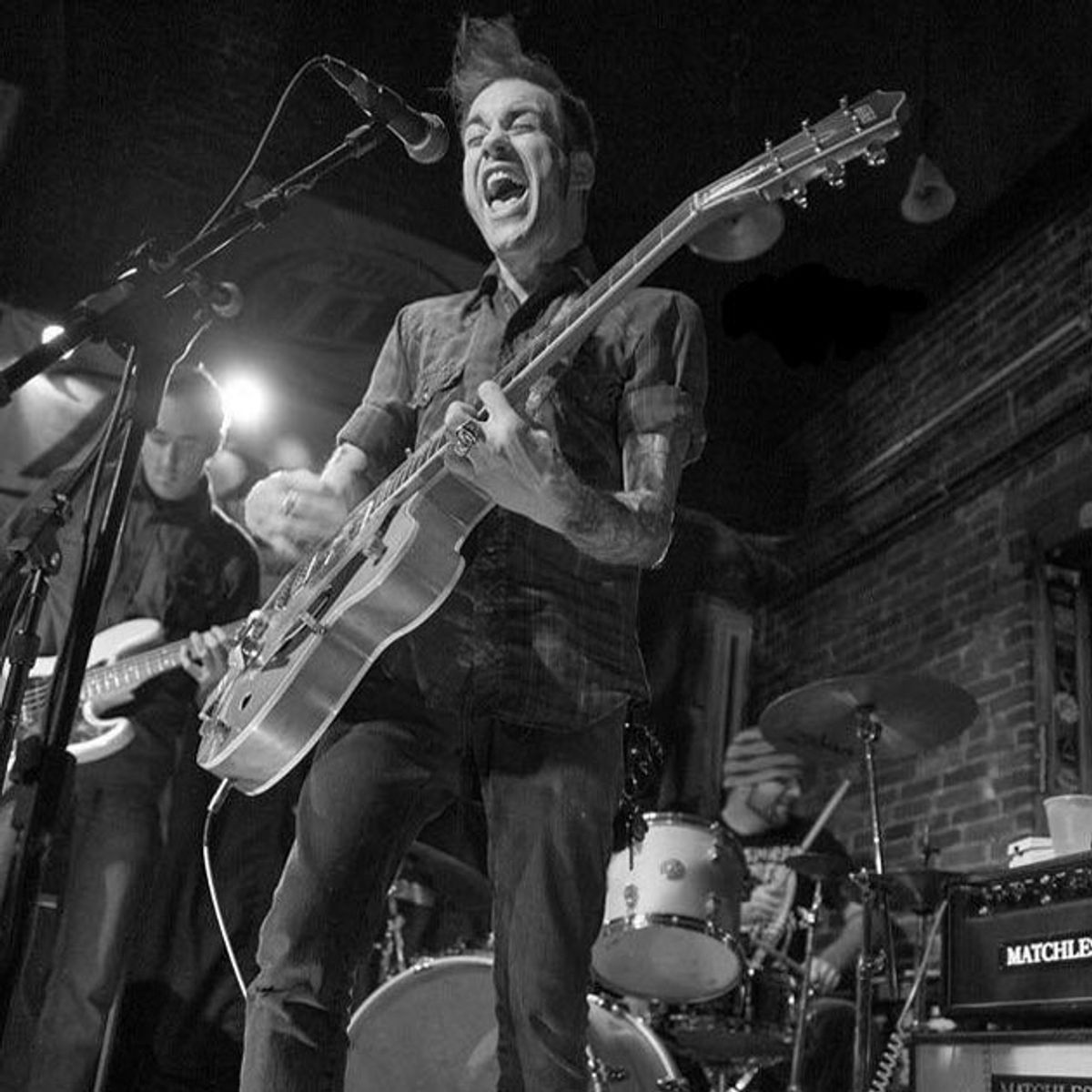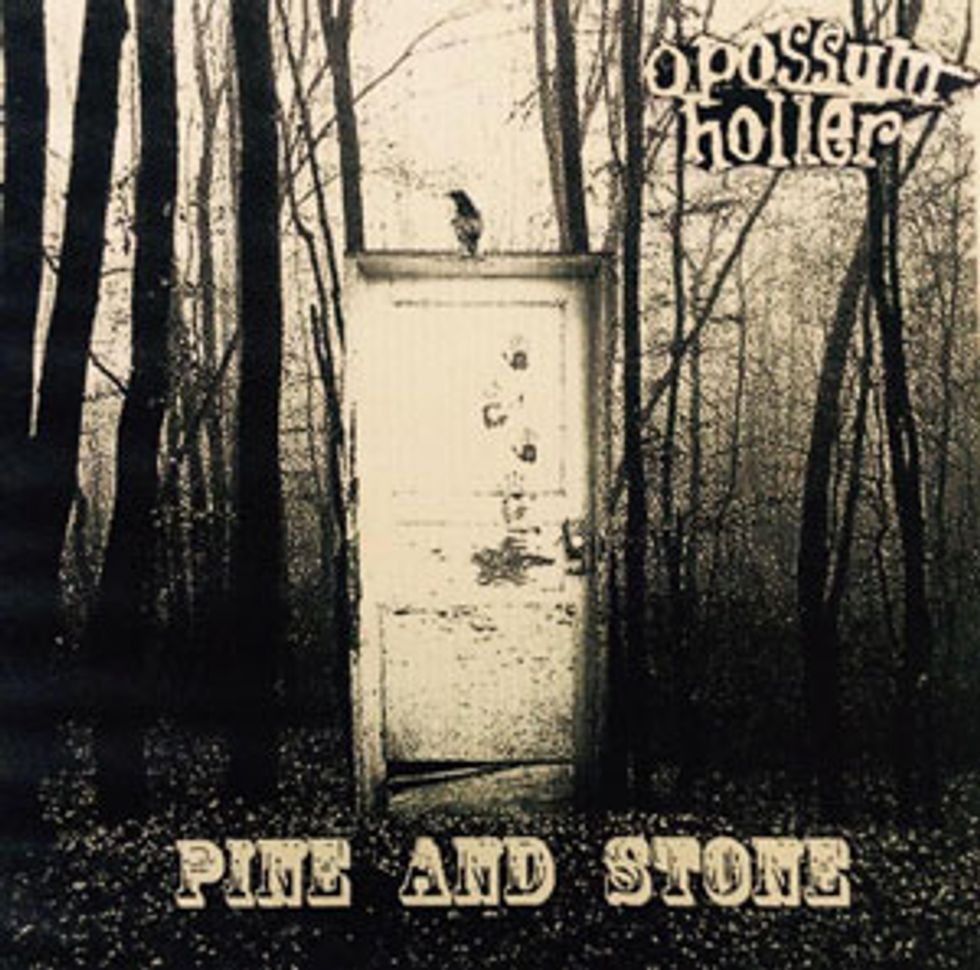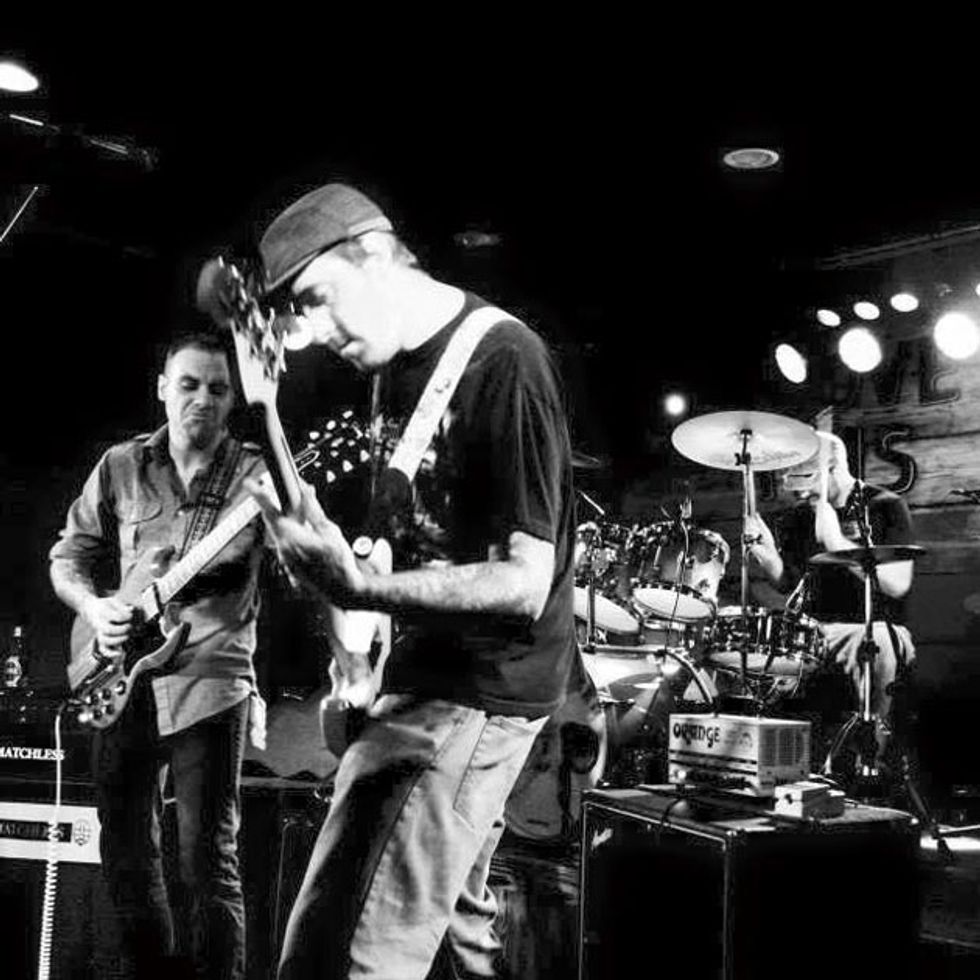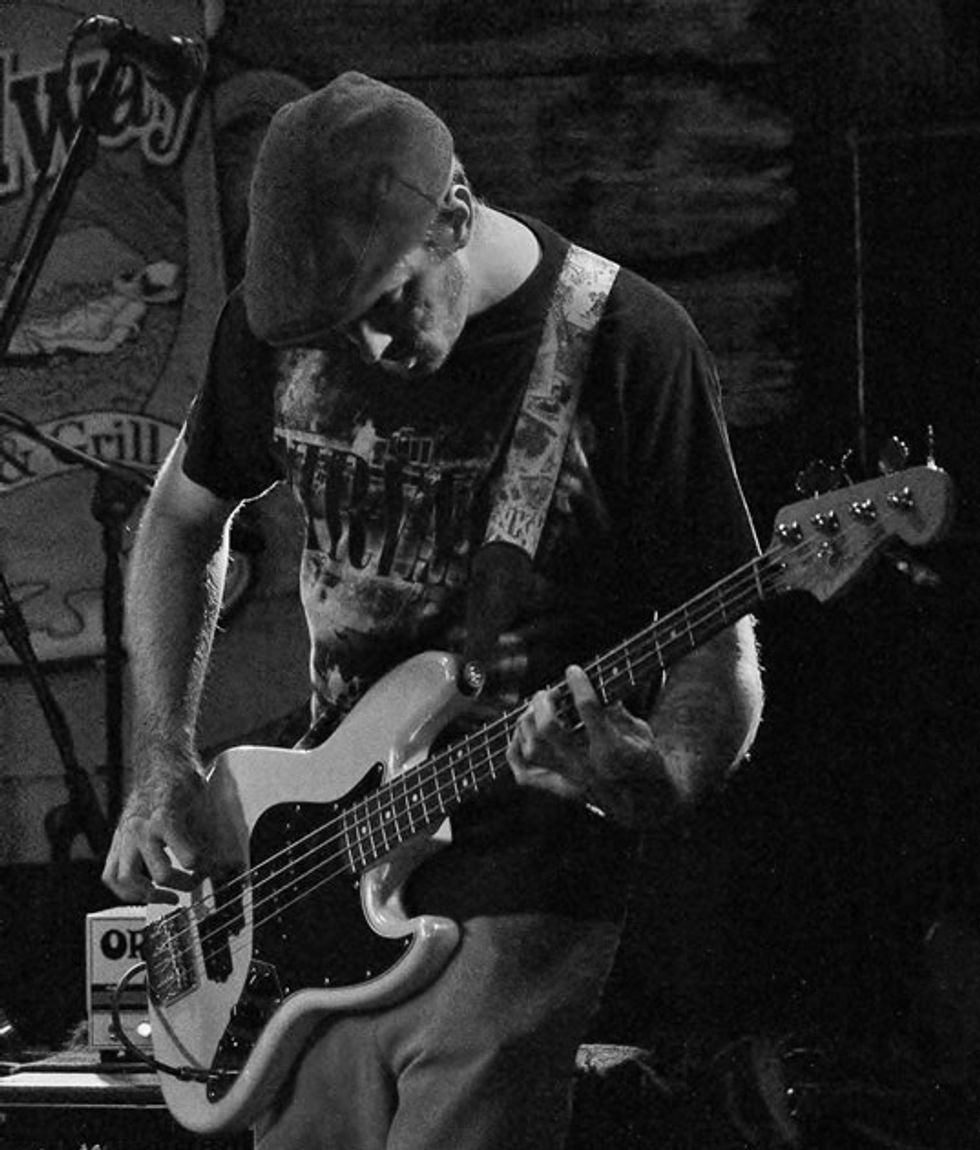
We sit down to talk with the Kentucky trio's guitarist and bassist about their adrenalin-fueled mix of B-movie references, grade-A riffs, and smarty-pants chords.
Kentucky-based rockers Opossum Holler play in the style of doomabilly: an eclectic mash-up of rockabilly and ’70s metal. It’s a high-energy cocktail, but also dynamic, dark, and introspective. The band is edgy, yet quirky and offbeat—and they’re not subtle. “I was influenced by anything B-horror movie related,” guitarist Lloyd Nicely says. “So that’s where most of it comes from.” The band is officially based in Bowling Green and released their first album, What’s Done Is Done, in 2011. Their lineup includes Nicely on guitar and vocals, plus drummer Matt DeVore and bassist Shelby Smith, who replaced founding bassist Brad Ausbrooks in 2014.
The power trio format suits Nicely just fine. He boasts virtuosic technique, superior tones, and an unorthodox perspective. “I was very influenced by Elvis and the rockabilly stuff,” he says. “I got really heavy into a lot of psychobilly music like Batmobile, Guana Batz, and, of course, Reverend Horton Heat. I always liked the Cramps—things like that—and I was very into Dick Dale.” Nicely also has an encyclopedic knowledge of vintage gear, which he puts to use working at Gruhn Guitars in Nashville. “I do the majority of the purchasing and consigning for the shop,” he explains.
The group’s alternative energy and first-class musicianship are getting them attention. Willie Adler from Lamb of God is a notable champion. “We never opened for them,” Nicely says about Lamb of God. “But [Adler] came and played a few dates with us. We have a song called “Sawdust,” and he will get onstage and play that tune with us from time to time.” Adler also makes an appearance in Opossum Holler’s camp horror video, “Hex,” as a bartender and undead motorist. Their most recent release, Pine and Stone, continues to wade knee-deep in the sonic marshlands and showcases Nicely’s fearless use of colorful chordal tensions (like 9s, 11s, and 13s) awash in fuzz. His ability to do that is a testament to his skill and finesse—not something you’d expect in a band as gritty as Opossum Holler.
We spoke with Nicely about crafting great tones, nuancing complex chord voicings from an oversaturated amp, finessing music from a belligerent vintage guitar, and the merits of recording everything live. Check out our sidebar with bassist Smith for added ’Possum perspective.
Who are some of your early influences?
The earliest stuff I listened to was probably the stuff my dad got me into. My dad was a professional bluegrass musician—a mandolin player. A lot of my earliest influences would probably be Johnny Cash, Bill Monroe. My dad was really into Bill Monroe, which really doesn’t reflect in my music at all [laughs]—but a lot of the early bluegrass stuff was very influential. And Elvis Presley was probably my largest influence ever.
What got you started playing guitar?
Oddly enough, it was my grandfather. He was a banjo player and he wanted somebody to play music with. He’d play banjo and I’d play flattop guitar. But mainly, for the rock ’n’ roll stuff, Tony Iommi may have been my biggest influence to pick up the electric guitar.
So in high school you discovered Black Sabbath and there was no looking back?
Exactly. Black Sabbath, Mountain, Deep Purple—it was not really metal, but it was like the very earliest forms of it. I figured that stuff out and I got into Nirvana—like that record Bleached—some of the ’90s stuff, Billy Corgan. All the stuff the kids got into at that point in time.
Harmonically, the chord voicings and progressions you use sound influenced by jazz. Did you listen to or study any of that music?
I wouldn’t say I’ve ever studied any music. I just hear stuff I think is cool or certain things I like the sound of and then I do my best to do my own interpretation of that. If I try to play a jazz riff or a jazz lick, I usually play it wrong [laughs]. I do like a lot of the old Gypsy jazz—like Django Reinhardt—that was always one of the things that was very fascinating to me. I’ve tried to put a little bit of that in there with my own twist on it.

Opossum Holler’s fifth and latest recording, Pine and Stone, is a seven-song EP that follows two previous albums, another EP, and a single. It was recorded in 2015, and features current bassist Shelby Smith, who joined the group in 2014.
When playing with lots of fuzz, how do you get the different notes in the more complex voicings to ring out?
Well, oddly enough, I don’t use anything but an amp and a guitar. I don’t have any pedals. I don’t even run a tuner into my line. I keep my tuner on top of my amp and then I use it between songs. I run my guitar straight into my amp and the way I make it dynamic is I use the volume control on my guitar.
You don’t even switch channels on the amp? Do you do everything with the volume control?
Yes. Even when we record. Our recordings are live. They are 100 percent the vocals, the guitar, the drums, and the bass. It’s done in one room.
No overdubs?
No. We don’t overdub anything unless it’s absolutely necessary. I like to make a record that sounds the way we actually sound. I don’t want to give somebody a record and say, “This is my band,” and then show up, play, and not sound anything like the record. It gives it more of a live, direct feel. I use my volume control a whole lot and I do switch pickups quite often. But that’s all I’m using: my guitar and my amp.
Was that a philosophical decision or just how it worked out?
I played in a lot of different bands when I was younger and I always had a problem when I wanted to go from a clean sound to a really overdriven sound. I was terrible. I would always hit the overdrive pedal at the wrong time and it didn’t work out [laughs]. At that point, I was using a ’65 Fender Mustang through a Twin with an overdrive pedal. What I did was I actually taped an overdrive pedal onto the top of my guitar so I could hit the overdrive with my hand instead of using my foot. I was just better doing that in time. Over the years I figured that I would turn my amp up as loud as it would go and I’d get the tone from wherever I rolled the volume. If it sounds good there, that’s where I’m going to have it.
So when you’re playing complex chord voicings, you roll the volume down a little bit more?
I do. That’s how I do it.
Inspired by the Rev. Horton Heat and other psychobilly guitarists as well as Tony Iommi and Django Reinhardt, Nicely has forged a unique and dirty approach to the instrument. Here he plays his ’69 Gibson SG onstage with his bandmates in Opossum Holler, bassist Shelby Smith and drummer Matt DeVore.
What amp do you use? I’ve got a 1970 Marshall MKII 50-watt head with the original 4x12 cabinet—original speakers and everything. It’s modded with a master. I’ve got a master in the back and I did that mod where you don’t have to drill out the chassis. You put the potentiometer for the master through the other input jack. For some of my other sounds I use a 30-watt Matchless HC-30 with a Matchless 2x12 cabinet.
Do you use the lower wattage so it breaks up at a lower volume?
I use the Matchless depending on where we’re playing. If it’s somewhere smaller, I’ll use it because I can turn it all the way up without killing everyone. If I’m playing an outdoor gig, I definitely take the Marshall. But I do prefer the Marshall over the Matchless. This Marshall is just real dirty and nasty. I haven’t done anything to it. The speakers are tired and it just gives you that ragged thing. It almost sounds like a giant fuzzbox.
In the studio you just crank it in an iso booth and go for it?
Well, no. I put it in an iso booth, but I open the door and I stand in front of it. So a lot of the recordings you can hear a whole bunch of guitar bleed into the vocals, which I like. But I like to be close to my amp when we record so that I can get some organic feedback. I don’t want to add anything that’s not there and I don’t want to add anything later. I want to be able to make the guitar feed back when I want to. Basically, I jump both the channels together and I turn it all the way up [laughs].
What have you learned about gear while working at Gruhn Guitars?
Oh gosh. I knew a lot. I’m not saying I knew a ton, but I’ve been studying vintage guitars since I was 13 or 14 years old. When I first started playing the guitar, for whatever reason, I just immediately knew I didn’t want a new guitar. I wanted an old guitar from the ’60s or the ’50s. I started reading books, and then the internet was available and I started researching there, and I used to come to Gruhn Guitars. When I was about 15 years old, the first electric guitar I ever bought was from this store. It was a ’63 Fender Jazzmaster. I’m very fortunate to work here. Since working here for George Gruhn, I’ve learned a tremendous amount. Not only about gear, but about sales. There is more information here than probably anywhere. I’ve learned about instruments I didn’t even know existed.
Lloyd Nicely’s Gear
Guitars1959 Gretsch 6120
1969 Gibson SG
1962 Gibson SG Standard
Amps
1970 Marshall MKII 50-watt head
1970 Marshall 4x12 cabinet
Matchless HC-30
Matchless 2x12 cabinet
Effects
None
Strings and Picks
D’Addario EXL 115 sets (.011–.049) with .049s replaced by (typically DR) .050s
Blue Dunlop Tortex 1.0 mm
And you prefer a big Gretsch guitar?
I have a Gretsch 6120. It was made in 1959. I bought that guitar quite a long time ago, before I worked at Gruhn. Brian Setzer always had one of those and Jim Heath [aka the Reverend Horton Heat] always played one, too. It’s just this big goofy-looking orange guitar and I was always drawn to that particular instrument. I actually had a reissue of that guitar and finally got an opportunity to buy a real one. That’s the main guitar I play. I have several other guitars, too, and live sometimes I’ll switch it up.
I saw you with an SG as well.
I’ve got a couple of SGs that I play. The brown one in the “Sawdust” video, that’s a ’69 SG. I have a ’62 SG Standard as well. As far as solidbodies, I really like the SG. It’s one of my favorite all-around rock ’n’ roll machines.
The neck on the SG must be completely different from the Gretsch.
Well, my Gretsch has a very small neck. I’ve played some of them that have a beefier style neck, but mine, for whatever reason, is exceptionally broken [laughs]. Before I got ahold of it, someone put superglue in the pickups to keep them from moving, the bridge is superglued onto the top of the guitar; it has terrible string action. I’ve never met anyone who was able to successfully play the guitar. It has a poor neck angle. But I like it the way that it is. You have to really fight the guitar to play it. If you’re playing barre chords in the upper register, you have to bend them into key. But I just like the guitar that way. It’s my favorite guitar.
Do you have any problems with the old vibrato arms on any of your guitars?
I don’t use the tremolos that are on my SGs. The one on the ’62 I have locked. It’s a side pull tremolo and it just doesn’t stay in tune. The other one, the ’69, it doesn’t stay in tune, either. But I use the Bigsby tailpiece on the Gretsch constantly. I can’t think of a time when I’m playing that guitar that I’m not using the tremolo bar.
What’s on the horizon?
We’re going back into the studio. We finished up and put out this little EP that we were working on [Pine and Stone]. And now I think we’re going to get back in the studio with [engineer/producer] David Barrick and try to hammer out another full-length record.
YouTube It
Vamping up Opossum Holler’s rock ’n’ horror aesthetic, the video for “Hex,” from the band’s 2011 debut album What’s Done Is Done, features Lloyd Nicely’s ragged and beloved 1959 Gretsch 6120 as well as a bevy of bloodsuckers and Lamb of God’s Willie Adler playing a bartender and a demonic car driver.
Guitar was Shelby Smith’s primary instrument before he started playing a modded Fender Jazz Bass in Opossum Holler, bringing a classic-rock approach into the band’s sound.
Marsupial Mega-Bass: Shelby Smith Powers Up
Bassist Shelby Smith joined Opossum Holler in the spring of 2014. He replaced outgoing bassist Brad Ausbrooks in preparation for that summer’s tour. But bass isn’t Smith’s first instrument. “I’ve been playing guitar for 20 years, since I was a teenager,” he says. “One day I ended up with a bass and I decided I was going to really focus on that. It’s been a couple or three years now that I’ve been really serious about the bass.”
Shelby Smith’s Gear
BassesFender Jazz Bass
5-string Music Man StingRay
Amps
Orange Terror Bass BT1000H
Ampeg SVT-610HLF cabinet
Effects
Electro-Harmonix Bass Big Muff Pi
Pro Co RAT
Boss Fender ’59 Bassman FBM-1
Strings and Picks
D’Addario Regular Light Gauge Chromes (.045–.100)
Opossum Holler synthesizes disparate styles, which wasn’t a difficult adjustment for Smith. “Drummer Matt Devore and I played in some more quirky avant-garde bands where we blended a lot of different genres,” says Smith. “That’s definitely the area I came from. I was able to understand that approach pretty easily going into it.” He’s also adding a different spice to the brew. “Brad was really influenced by Clutch, Weedeater, and Fu Manchu. He approached the writing on bass from that stoner-rock and high-octane, punk-driven rock ’n’ roll perspective. I wanted to approach things from more of a classic-rock perspective. I put my spin on what they were doing.”
Smith uses a modified Fender Jazz Bass. “I switched out the pots and the wiring with a vintage wiring kit,” he says. “It’s a few years old but it’s a great bass. It’s a Jazz Bass that has two P-style pickups on it.” He also has a 5-string Music Man StingRay. His amp is a 1,000-watt Orange Terror bass head run through a 6x10 Ampeg HLS cabinet. “It gets pretty loud, but it’s one of those class D tube/solid-state hybrids. It doesn’t get as crazy as you might think.” Although it did affect his choice in strings. “The Orange Terror bass head has a really deep, rumbly tone, so I like bright strings to balance it out a bit.” And unlike his bandmate Lloyd Nicely, Smith doesn’t have an aversion to pedals. He uses a Bass Big Muff Pi and a RAT for fuzz, plus a Boss Fender ’59 Bassman as a boost.


